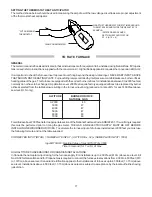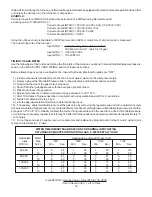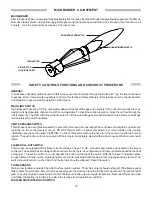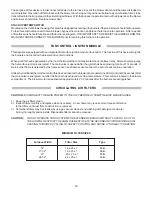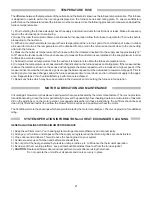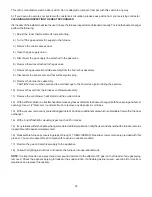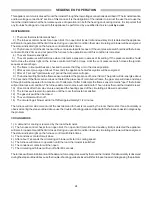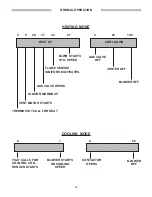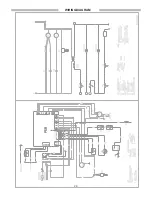
21
TEMPERATURE RISE
The difference between the temperature of the outlet air and the inlet air is known as the furnace temperature rise. This furnace
is designed to operate within the rise range displayed on the furnace series and rating plate. To ensure satisfactory
performance, the temperature rise of the furnace must be measured. Use the following procedure to measure and adjust the
furnace temperature rise:
1.) Prior to starting the furnace visually check the supply and return air ducts for restrictions or leaks. Make all necessary
repair to the ductwork prior to continuing.
2.) Adjust the room thermostat to obtain a continuous burner operation. Allow the furnace to operate for 15 minutes before
proceeding to the next step.
3.) With an accurate thermometer measure the air temperature at the return air grille. If a combination of indoor / outdoor
air is used for return air, the temperature must be obtained from a point in the return air ductwork close to the connecting
point with the furnace.
4.) Measure the outlet air temperature of the furnace with a thermometer inserted into the supply duct approximately 12"
to 18" above the furnace outlet. It may be necessary to measure the outlet air in several places in the supply plenum in order
to obtain an accurate average.
5.) Subtract the inlet air temperature from the outlet air temperature to obtain the furnace temperature rise.
6.) Compare the temperature rise measured with that indicated on the furnace series and rating plate. If the measured rise
is above the tolerance shown on the series and rating plate the blower speed must be increased (a higher speed). If the
measured rise is below the furnace design rise range the blower speed must be decreased (a lower motor speed). Prior to
making any motor speed changes allow the furnace adequate time to cool down, and turn off electric supply to the appli-
ance. Repeat steps 2 thru 5 until satisfactory performance is achieved.
7.) Repair any holes which may have been made in the ductwork prior to putting the furnace into operation.
MOTOR LUBRICATION AND MAINTENANCE
Circulating air blower motor has sleeve bearings which are prelubricated by the motor manufacturer. There is no provision
for additional oiling. Clean the motor periodically to prevent the possibility of overheating due to an accumulation of dust and
dirt on the windings or on the motor exterior. As suggested elsewhere in these instructions, the air filters should be kept
clean. Dirty filters will restrict the airflow the blower motor requires and possibly overheat the motor.
The Vent Blower motor has bearings which are prelubricated by the motor manufacturer. There is no provision for additional
oiling.
SYSTEM OPERATION INFORMATION and HEAT EXCHANGER CLEANING
GENERAL GUIDELINES FOR MAXIMUM PERFORMANCE
1.) Keep the air filters clean. Your heating system will operate more efficiently and economically.
2.) Arrange your furniture and drapes so that the supply air registers and the return air grilles are unobstructed.
3.) Close doors and windows. This will reduce the heating load on your system.
4.) Avoid excessive use of kitchen and bathroom exhaust fans.
5.) Do not permit the heat generated by television, lamps, radios, etc. to influence the thermostat operation.
6.) Exclusive of the mounting platform, keep all combustible articles three feet from the furnace jacket.
7.)
CAUTION:
Replace all blower doors and compartment covers after servicing the furnace.
Do not operate the unit without all panels and doors securely in place.
Содержание GMN SERIES
Страница 26: ...WIRINGDIAGRAM 26...











